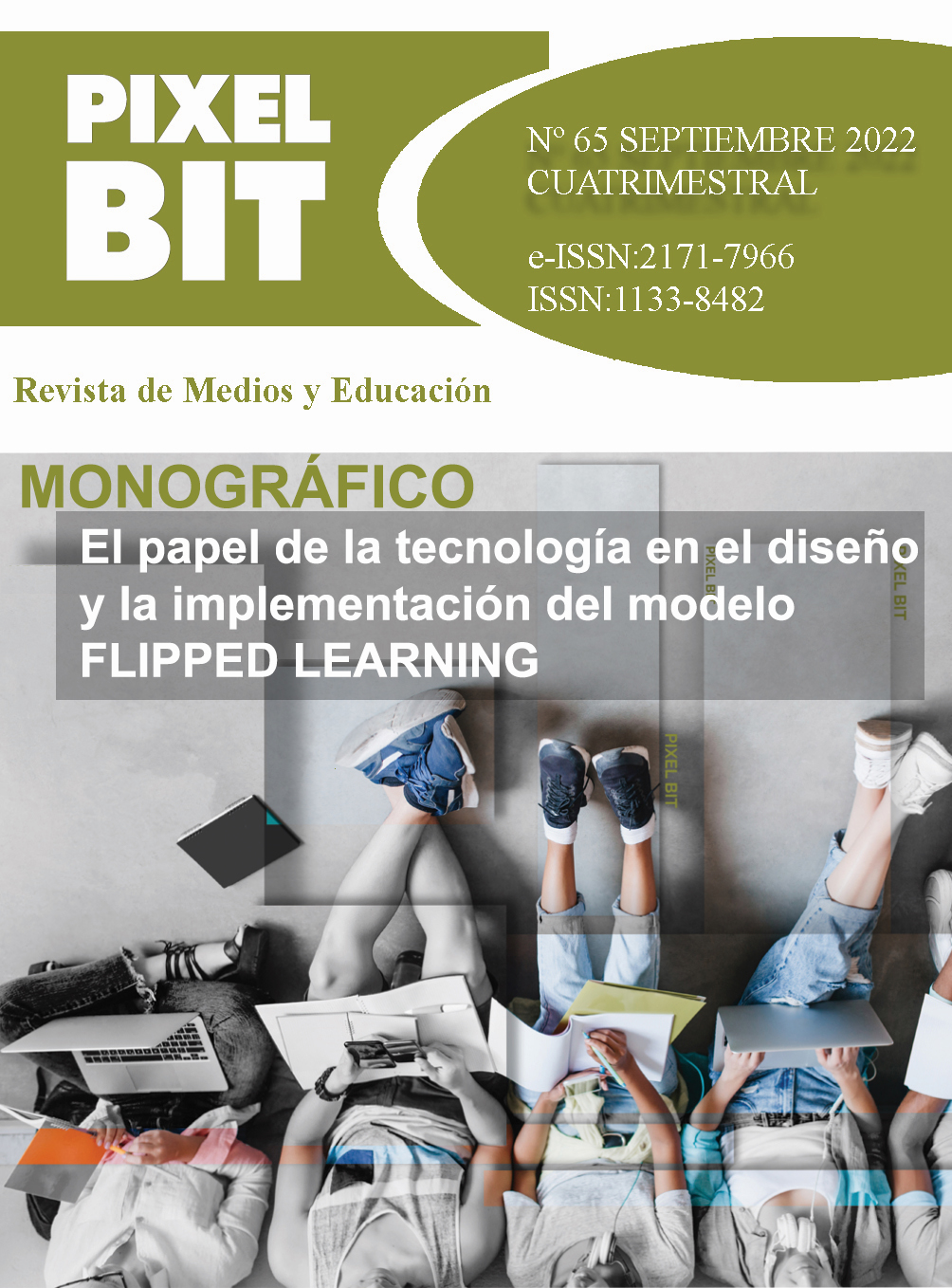Resumen
La necesidad de replantear el proceso de aprendizaje en asignaturas de marcado corte reflexivo en la formación de Maestros/as abre la puerta a la implementación de una estrategia formativa inversa, en la que las lecturas y los vídeos anticipan el primer contacto del alumnado con los conceptos relevantes, para después problematizarlos dialógicamente durante la clase presencial. Analizar esa propuesta durante los cursos 2019/20 y 2021/22, a partir de un cuestionario de satisfacción del alumnado (N=294), sus calificaciones semestrales y los datos de consumo de los recursos tecnológicos permite validar la propuesta, especialmente favorable para el alumnado que asiste habitualmente a las clases y participa en ellas, y permite confirmar que el aumento de las cargas de trabajo no es excesivo. Asimismo, se analiza la relación entre la clase presencial y los recursos educativos digitales propuestos, y se concluye que, lejos de suplirla, los recursos complementan y refuerzan las dinámicas de clase (también de modo más intenso para los que más asisten a ellas y participan).
Citas
Aronson, N., & Arfstrom, K. M. (2013). Flipped Learning in Higher Education. In Always Learning. Pearson. https://doi.org/10.4018/978-1-59904-935-9.ch274
Ash, K. (2012). Educators view flipped model with a more critical eye. Education Week, 32(2), S6–S7.
Bergmann, J., & Sams, A. (2008). Relaxing Chemistry Class. Learning & Leading with Technology, Dec-Jan(2008–09), 22–27.
Blair, E., Maharaj, C., & Primus, S. (2016). Performance and perception in the flipped classroom. Education and Information Technologies, 21(6), 1465–1482. https://doi.org/10.1007/s10639-015-9393-5
Brewer, R., & Movahedazarhouligh, S. (2018). Successful stories and conflicts: A literature review on the effectiveness of flipped learning in higher education. In Journal of Computer Assisted Learning (Vol. 34, Issue 4, pp. 409–416). Blackwell Publishing Ltd. https://doi.org/10.1111/jcal.12250
Cecchinato, G. (2014). Fliped Classroom: innovare la scuola con le tecnologie digitali. TD Tecnologie Didattiche, 22(1), 11–20.
Coates, H. (2006). Student Engagement in Campus-Based and Online Education. Routledge. https://doi.org/https://doi.org/10.4324/9780203969465
Comber, D. P. M., & Brady-Van den Bos, M. (2018). Too much, too soon? A critical investigation into factors that make Flipped Classrooms effective. Higher Education Research and Development, 37(4), 683–697. https://doi.org/10.1080/07294360.2018.1455642
Foschi, L. C., & Cecchinato, G. (2018). Flipped classroom: risultati di una sperimentazione condotta presso l’IIS Bosso-Monti di Torino. RicercAzione. Six-Monthly Journal on Learning, Research and Innovation in Education, 10(1), 195–216.
Foschi, L. C., & Cecchinato, G. (2020). Perusall: University learning-teaching innovation employing social annotation and machine learning. Qwerty. Open and Interdisciplinary Journal of Technology, Culture and Education, 15(2), 45–67. https://doi.org/10.30557/QW000030
Goodwin, B., & Miller, K. B. (2013). Evidence on Flipped Classrooms Is Still Coming In. Research Says, by the ASCD. https://www.ascd.org/el/articles/evidence-on-flipped-classrooms-is-still-coming-in
Gündüz, A. Y., & Akkoyunlu, B. (2019). Student views on the use of flipped learning in higher education: A pilot study. Education and Information Technologies, 24(4), 2391–2401. https://doi.org/10.1007/s10639-019-09881-8
Lage, M. J., Platt, G. J., & Treglia, M. (2000). Inverting the classroom: A gateway to creating an inclusive learning environment. Journal of Economic Education, 31(1), 30–43. https://doi.org/10.1080/00220480009596759
Marcey, D. J. (2014). The Lecture Hall as an Arena of Inquiry: Using Cinematic Lectures and Inverted Classes (CLIC) to Flip an Introductory Biology Lecture Course. Academic Commons.
Martín Rodríguez, D., & Santiago, R. (2015). ¿Es el flipped classroom un modelo pedagógico eficaz? Un estudio sobre la percepción de estudiantes de Primaria, ESO y Bachillerato? Comunicación y Pedagogía, 285–286.
McLaughlin, J. E., Griffin, L. T. M., Esserman, D. A., Davidson, C. A., Glatt, D. M., Roth, M. T., Gharkholonarehe, N., & Mumper, R. J. (2013). Pharmacy student engagement, performance, and perception in a flipped satellite classroom. American Journal of Pharmaceutical Education, 77(9). https://doi.org/10.5688/ajpe779196
Mezirow, J. (1996). Contemporary Paradigms of Learning. Adult Education Quarterly, 46(3), 158–172. https://doi.org/10.1177/074171369604600303
Michael, J. (2006). Where’s the evidence that active learning works? American Journal of Physiology - Advances in Physiology Education, 30(4), 159–167. https://doi.org/10.1152/advan.00053.2006
Mishra, P., & Koehler, M. J. (2006). Technological Pedagogical Content Knowledge: A Framework for Teacher Knowledge. Teachers College Record, 108(6), 1017–1054. http://punya.educ.msu.edu/publications/journal_articles/mishra-koehler-tcr2006.pdf
O’Flaherty, J., & Phillips, C. (2015). The use of flipped classrooms in higher education: A scoping review. Internet and Higher Education, 25, 85–95. https://doi.org/10.1016/j.iheduc.2015.02.002
Pierce, R., & Fox, J. (2012). Vodcasts and active-learning exercises in a “flipped classroom” model of a renal pharmacotherapy module. American Journal of Pharmaceutical Education, 76(10). https://doi.org/10.5688/ajpe7610196
Pluta, W. J., Richards, B. F., & Mutnick, A. (2013). PBL and Beyond: Trends in Collaborative Learning. Teaching and Learning in Medicine, 25(SUPPL.1). https://doi.org/10.1080/10401334.2013.842917
Raffaghelli, J. E. (2017). La Flipped Classroom funziona? Analisi critica di evidenze empiriche sulla sua efficacia per l’apprendimento. Does Flipped Classroom work? Critical analysis of empirical evidences on its effectiveness for learning. Form@re. Open Journal per La Formazione in Rete, 17(3), 116–134. https://doi.org/http://dx.doi.org/10.13128/formare-21216
Santiago, R. (2019). Connecting the Flipped Learning model and the Multiple Intelligen-ces Theory considering Bloom’s taxonomy. Magister, 31(2), 45–54. https://www.uniovi.es/reunido/index.php/MSG/index
Santiago, R., & Bergmann, J. (2018). Aprender al revés. Flipped learning 3.0 y metodologías activas en el aula. Paidós.
Sargent, J., & Casey, A. (2020). Flipped learning, pedagogy and digital technology: Establishing consistent practice to optimise lesson time. European Physical Education Review, 26(1), 70–84. https://doi.org/10.1177/1356336X19826603
Zhao, L., He, W., & Su, Y. S. (2021). Innovative Pedagogy and Design-Based Research on Flipped Learning in Higher Education. Frontiers in Psychology, 12. https://doi.org/10.3389/fpsyg.2021.577002

Esta obra está bajo una licencia internacional Creative Commons Atribución-NoComercial-SinDerivadas 4.0.
Derechos de autor 2022 Pixel-Bit. Revista de Medios y Educación

